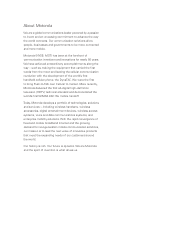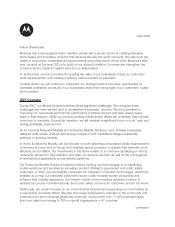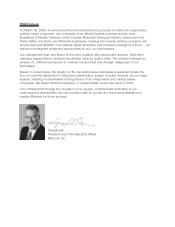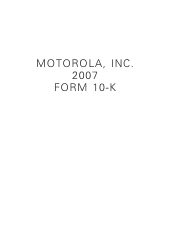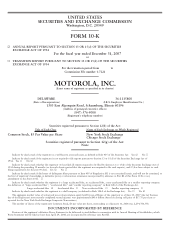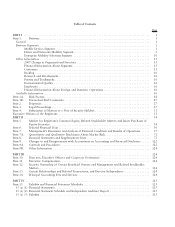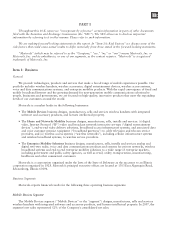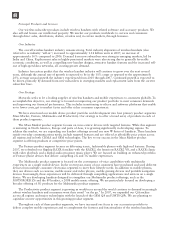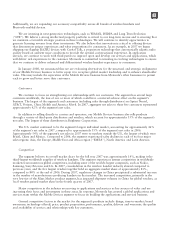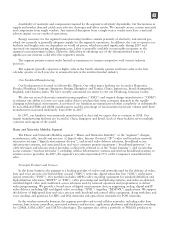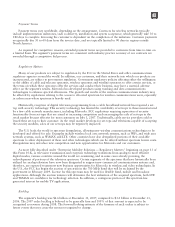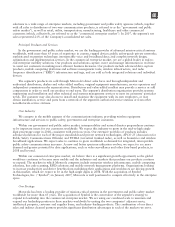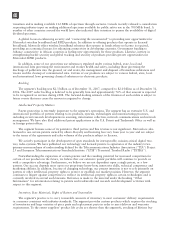Motorola 2007 Annual Report Download - page 12
Download and view the complete annual report
Please find page 12 of the 2007 Motorola annual report below. You can navigate through the pages in the report by either clicking on the pages listed below, or by using the keyword search tool below to find specific information within the annual report.
Payment Terms
The segment’s customers and distributors buy from us regularly with payment terms that are competitive with
current industry practices. These terms vary globally and generally range from cash-with-order to 60 days.
Extended payment terms beyond 60 days are provided to customers on a limited basis. A customer’s outstanding
credit at any point in time is limited to a predetermined amount as established by the Company.
Regulatory Matters
Radio frequencies are required to provide wireless services. The allocation of frequencies is regulated in the
U.S. and other countries, and limited spectrum space is allocated to wireless services. The growth of the wireless
and personal communications industry may be affected if adequate frequencies are not allocated or, alternatively, if
new technologies are not developed to better utilize the frequencies currently allocated for such use. Industry
growth may also be affected by the cost of the new licenses required to use frequencies and any related frequency
relocation costs.
The U.S. leads the world in spectrum deregulation, allowing new wireless communications technologies to be
developed and offered for sale. Examples include wireless local area network systems, such as WiFi, and wide area
network systems, such as WiMAX and LTE. Other countries have also deregulated portions of their available
spectrum to allow deployment of these and other new technologies, which can be offered without spectrum license
costs. Deregulation may introduce new competition and new opportunities for Motorola and our customers. In
addition, Mobile WiMAX was recently approved as a global IMT (International Mobile Telecommunications)
standard. This action lays the foundation to further expand mobile WiMAX in key bands, making additional
spectrum available globally.
In January 2008, the Federal Communications Commission (“FCC”) began its auction of 700 MHz band
spectrum licenses in the United States. This spectrum can carry large amounts of data across long distances and
penetrate walls easier than higher frequencies, enhancing in-building coverage. The open-access conditions are
intended to help foster innovation in handsets and applications, however the actual impact of the new licenses is
unclear. The open access provision applies to approximately one-third of the U.S. spectrum being auctioned and
prevents the licensee from blocking devices or applications that are compatible with the network.
Backlog
The segment’s backlog was $647 million at December 31, 2007, compared to $1.4 billion at December 31,
2006. This decrease in backlog is primarily due to a decline in customer demand driven by gaps in the segment’s
product portfolio. The 2007 backlog is believed to be generally firm and 100% of that amount is expected to be
recognized as revenue in 2008. The forward-looking estimate of the firmness of such orders is subject to future
events that may cause the amount recognized to change.
Intellectual Property Matters
Patent protection is extremely important to the segment’s operations. The segment has an extensive portfolio
of patents relating to its products, technologies and manufacturing processes. The segment licenses certain of its
patents to third parties and generates revenue from these licenses. Motorola is also licensed to use certain patents
owned by others. Royalty and licensing fees vary from year to year and are subject to the terms of the agreements
and sales volumes of the products subject to licenses. The protection of these licenses is also important to the
segment’s operations. Reference is made to the material under the heading “Other Information” for additional
information relating to patents and trademarks and research and development activities with respect to this
segment.
Inventory, Raw Materials, Right of Return and Seasonality
The segment’s practice is to carry reasonable amounts of inventory in manufacturing and distribution centers
in order to meet customer delivery requirements in a manner consistent with industry standards. At the end of
2007, the segment had a lower inventory balance than at the end of 2006. The decrease reflects the significant
decline in sales volumes during 2007, as well as an ongoing emphasis on managing inventory levels.
4


